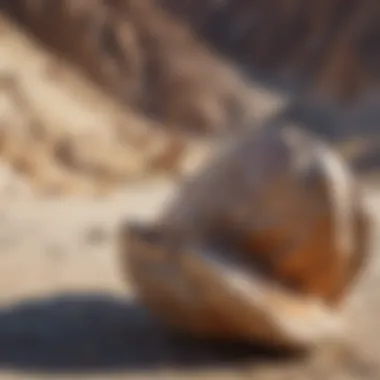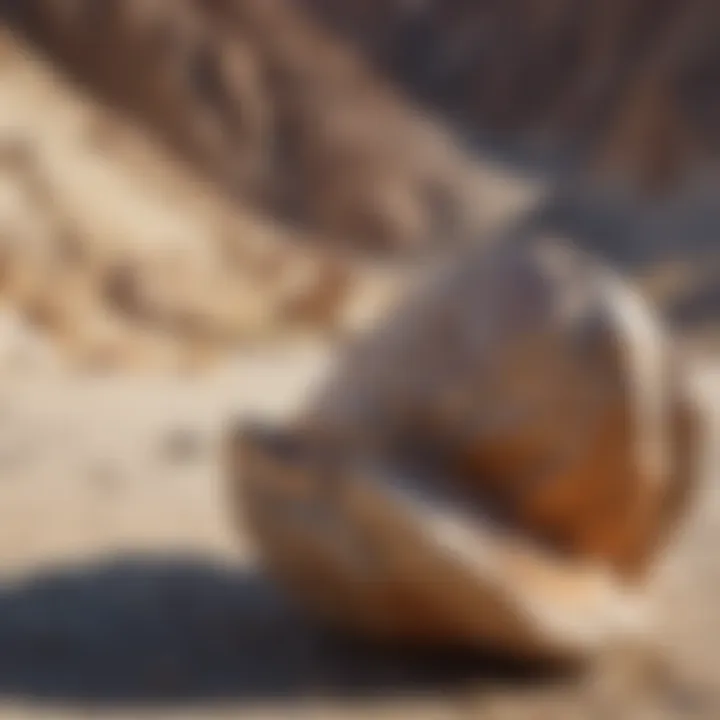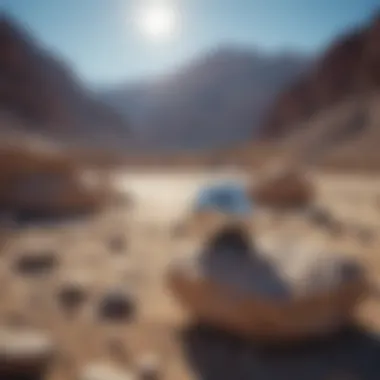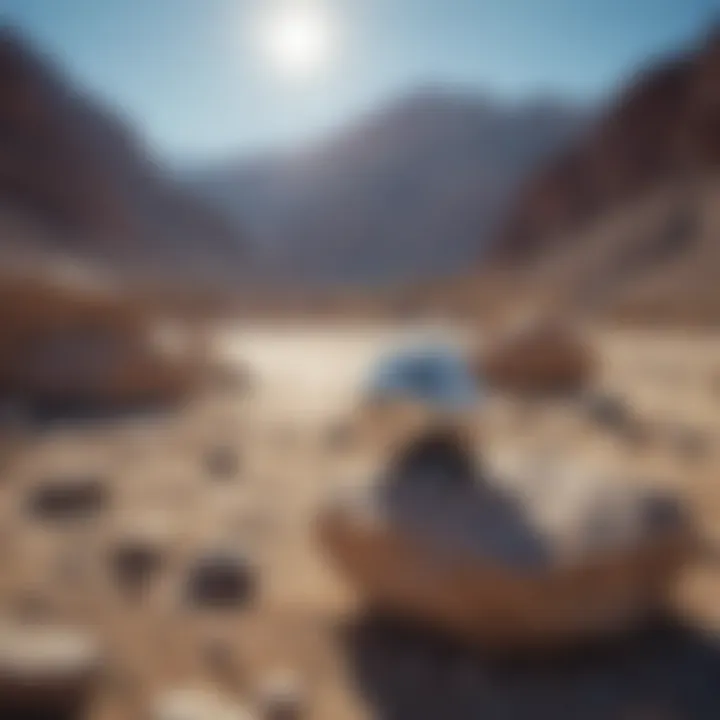The Fascinating Mechanics Behind Rock Movement in Death Valley


Intro
Death Valley is not just a barren landscape; it’s a stage for one of nature's most curious and unlikely performances, the movement of rocks across its parched flats. This phenomenon has amused and baffled scientists, explorers, and travelers alike. How is it possible that these seemingly inert rocks, left exposed to the elements, can travel across the desert floor? To understand this unusual spectacle requires peeling back layers of geology, physics, and environmental conditions.
With a mix of heat, wind, and the unique terrain of Death Valley, the forces involved create a rare combination that initiates motion in rocks that can weigh hundreds of pounds. It's like nature's own version of choreography, with rocks as the unknowing dancers on an expansive stage. This article will explore the underlying causes of this movement, with a keen eye on the scientific studies that seek to unravel the enigma. We’ll also touch on the historical observations that have forever altered our understanding of geological processes.
As we delve deeper, the narrative will resonate with rock and fossil collectors, enthusiasts, and the curious minds who are eager to grasp the complexities of this phenomenon. Prepare to uncover the remarkable interplay of forces at work in one of the most unique geological settings on Earth.
Prelude to Death Valley
Death Valley holds a unique place in the American landscape, serving as both a geographic marvel and a site of intrigue for geology enthusiasts. Its extreme conditions and diverse geological features provide a captivating backdrop for understanding natural phenomena, notably the movement of rocks across its parched floor. This exploration of rock motion isn’t merely a curiosity; it embodies broader geological processes at work in Earth’s crust, allowing both hobbyists and serious collectors to engage deeply with the environment.
Geographical Overview
Nestled in California, Death Valley is not just the driest but also the hottest national park in the United States. The terrain is marked by vast salt flats, towering mountain ranges, and deep canyons, creating an ever-changing tableau of nature. Among these features, the Racetrack Playa stands out as the stage for the incredible phenomenon of moving rocks, where stones seem to glide effortlessly across the surface. This occurrence invites a deeper investigation into how and why these rocks shift, challenging even seasoned geologists.
- Key features of Death Valley:
- Racetrack Playa: A flat, dry lakebed known for its mysterious rock movement.
- Salt flats: The white crust of salt stretches for miles, an intriguing formation in its own right.
- Mountain ranges: The Panamint and Amargosa ranges frame the valley, contributing to its unique weather patterns.
These elements work together to foster conditions that facilitate the movement of rocks, capturing the attention of scientists and observers alike. A closer examination of this geographical context reveals why Death Valley is an invaluable resource for understanding geology.
Historical Significance
The history of Death Valley adds another layer to its allure. Native American tribes, such as the Timbisha Shoshone, have inhabited the region for centuries, holding knowledge of its natural rhythms and quirks. Explorers and settlers recorded their experiences in the arid expanse, often with a sense of awe and bewilderment. This significant cultural backdrop provides context to the scientific investigations that followed.
In the late 19th century, as miners sought precious metals, the area began to garner more attention. However, it wasn't until the 20th century that geologists began systematically studying the rock movements. The fascinating observations made in this region have continually fueled research and added depth to discussions about geological processes globally.
"Death Valley is a place where nature tells its stories not just through formations, but through the movement of stones that have captivated observers for ages."
Not only does Death Valley serve as a testament to natural beauty and geologic phenomena, it also plays a crucial role in the narrative of Earth's history. Knowledge gained from studying its rocks and their movements can lead to greater insights into processes that govern our planet.
The exploration of these themes sets the stage for understanding the remarkable mechanics behind the movement of rocks in Death Valley, an endeavor that intrigues rock and fossil collectors while shedding light on a captivating aspect of Earth’s geology.
The Phenomenon of Moving Rocks
Rocks moving in Death Valley is not just a curious spectacle; it's a powerful lens through which we can examine the interaction of geological processes and environmental conditions. This phenomenon, while seemingly simple at first glance, opens up a treasure trove of insights about the natural world, particularly for those who collect, study, or simply appreciate rocks and fossils. Understanding it can connect the threads of history, science, and passion in one seamless narrative.
At its core, the movement of rocks in this arid landscape showcases the interplay of forces that shape our planet. For rock and fossil collectors, grasping the nuances behind this movement can enhance not just their collections but also their understanding of Earth's evolving surface. This is essential knowledge gleaned from observing phenomena like sedimentary shifts and erosion over time.
In-depth investigations illuminate critical insights about local weather patterns, soil composition, and even gravitational influences. With each moving stone, scientists are piecing together not just a scientific puzzle, but a narrative about our planet's geological past.
Understanding Rock Motion
Understanding the mechanics behind rock motion is vital for studying this phenomenon. Rocks, while seeming immovable, are influenced by multiple forces acting upon them. A combination of temperature fluctuations, soil wetness, and wind patterns play a starring role in how these rocks behave.
A key element here is the role of frost action. When temperatures drop at night, moisture in the soil can freeze, expanding and contracting as it thaws during the day. This freeze-thaw cycle can create a slight push, nudging the rocks just enough to set them in motion.
Additionally, the angle of inclination of the ground where these rocks rest adds another layer of complexity. If the terrain isn’t perfectly flat, even the lightweight breeze can initiate a slow roll. It's this understanding of the subtle adjustments within nature that ultimately leads to the fascinating shifts of these wandering stones.
Types of Movement


Not all movement is created equal when it comes to rocks in Death Valley. There are several interesting types of movements that can be documented, each carrying unique characteristics.
- Sliding: This form of movement is often noted on steeper slopes where rocks gradually descend. It can resemble more of a slow cascade rather than a sudden fall, often leaving trails behind.
- Rolling: This movement is more common in the sandy areas of Death Valley. Rocks can roll, propelled by wind or collected water, creating small ditches along their path.
- Pushing/ Shifting: Sometimes, larger rocks can be pushed across flat grounds by either the wind or the elemental force of water after a rainstorm, sparking curiosity about the real drivers of these changes.
"The dance of rocks across the landscape is a reminder that even the seemingly inert can engage in the artistry of nature's hand."
In summary, the movements of rocks in Death Valley, while they might appear trivial at a glance, offer profound insights. They encompass various types of motion that branch into larger conversations about geological and environmental influences. Collectors and enthusiasts alike can further appreciate these intricacies, adding depth to their understanding of this breathtaking location.
Geological Context
Understanding the geological context of Death Valley is paramount to fully appreciating the phenomena that take place within its rocky expanse. This region, often characterized by its harsh climate and dramatic landscapes, holds answers not only to questions about the movement of its rocks but also sheds light on broader geological and environmental processes.
Composition of Death Valley Rocks
The rocks that populate Death Valley are as varied as the colors one might find in a box of crayons. These rocks are primarily comprised of sedimentary, igneous, and metamorphic types, each contributing uniquely to the landscape's allure. The desert varnish, a thin coating of iron and manganese oxides, gives some stones that distinct shimmer, making them stand out against their otherwise arid surroundings.
There are also large expanses of gravel and sandstone, which suggest a history of erosion and sedimentation, dating back millions of years. Limestone deposits often hint at ancient aquatic environments, telling tales of a time when this now parched land was under water. Understanding this assembly of rock types not only enhances our appreciation of their movement but underscores the complex history of geologic events that shaped Death Valley, from volcanic eruptions to tectonic shifts.
Surrounding Geological Features
To gain a holistic view of geological processes at play in Death Valley, one must not look just at the valley itself. Surrounding features like the Panamint Mountains and the Amargosa Range frame the valley, presenting a dramatic contrast between high peaks and deep depressions. These mountain ranges are essential in understanding the climatic conditions that influence rock movement, as they trap moisture and create microclimates.
The interplay of faults also defines this landscape. The prominent San Andreas Fault system runs nearby, contributing to the tectonic activity that characterizes the region. As plates shift and settle, they create stresses that sometimes release in the form of earthquakes, which can further influence rock displacement over time.
Conditions such as wind erosion, occasional rainfall, and temperature extremes all collaborate to create unique geological phenomena.
In sum, the geological context of Death Valley presents a multifaceted investigation into the Earth’s processes. Each rock tells a story, shaped by history and the forces that govern our planet. The surrounding geological features not only enhance our understanding of the rocks' movement but also enrich the narratives that make Death Valley a geological haven.
Historical Observations
The realm of Death Valley is more than just a harsh landscape; it's a stage where nature performs captivating dramas that have piqued curiosity for centuries. Historical observations play a pivotal role in understanding the unique phenomenon of moving rocks, illustrating how the collective awareness of this occurrence has evolved. Delving into past accounts allows enthusiasts and scholars alike to appreciate how these stones have mesmerized those who ventured into this wild place. The knowledge amassed over the years not only serves to unearth the methods these rocks employ in their silent journeys but also accentuates our connection to the geological narrative of Earth.
Early Accounts and Discoveries
Throughout time, the moving rocks of Death Valley have not gone unnoticed. Early accounts are often colored with wonder and bafflement. One of the first mentions dates back to the early 20th century when folks started sharing tales about the rocks seemingly hovering or sliding across the dry lake beds. These stories struck a chord, inspiring many to trek into the valley in search of these elusive phenomena. Local legends whispered about rocks that moved on their own, stirring imaginations while prompting visitors to debate the forces at work.
"The rocks, with their peculiar trails, beckoned like characters in an ancient fable, a testament to nature's marvels in a landscape devoid of life."
Field observations began to flourish as more explorers found their way to the valley, documenting strange tracks left behind by the rocks. The human inclination towards narrating such encounters not only forged a sense of adventure but also laid the groundwork for later scientific inquiries. As one early document suggests, the moving rocks were even seen as 'nature's riddle' awaiting resolution.
Scientific Investigations through the Years
As decades rolled by, scientific investigations began peeling back the layers of mystery surrounding rock movement in Death Valley. Researchers approached this phenomenon with a blend of skepticism and fascination, compelled by the unexplainable trails etched into the earth. Using a combination of observational studies and empirical methods, scientists endeavored to unlock the tale of these wayward stones.
By the 1970s, attention shifted from anecdotal evidence to rigorous analysis. What emerged were hypotheses centered around environmental conditions; shifts in wind patterns, and rare weather occurrences. Detailed studies during this time revealed fascinating interactions between temperature fluctuations and the unique soil composition of the valley, leading to the hypothesis that ice can form beneath the rocks, acting as a lubricant when conditions are just right.
Field researchers equipped with modern technology began utilizing GPS and remote sensing; this shift to tech-savvy methods produced more substantial data supporting earlier claims.
In recent years, novel studies even invited the public and hobbyists to engage in monitoring these very rocks, showcasing a contemporary synergy where science meets community involvement. The historical trajectory of research showcases a vibrant dialogue between observations made by early explorers and cutting-edge scientific methodologies. This lineage of inquiry continues to inspire and educate, ensuring that the stories of moving rocks are far from over.
In sum, the historical exploration of moving rocks in Death Valley illustrates a dynamic journey. From folklore to scientific inquiry, this phenomenon has woven a rich tapestry of knowledge, beckoning future generations of geological enthusiasts to continue the search for meaning behind the extraordinary.


Physical Forces at Work
Understanding the physical forces at work in Death Valley is pivotal for grasping how and why rocks move across its parched plains. The interaction of various elements contributes significantly to this seemingly magical action of these stones. The discussion unfolds through a closer examination of three primary forces: weather patterns, soil composition, and gravity. These elements not only help explain the mechanics behind rock movement but also underscore the complex relationships that define our planet's geology.
Role of Weather Patterns
Weather in Death Valley can be as fickle as a cat on a hot tin roof. Periods of extreme heat can be interspersed with sudden bursts of rain. This fluctuation in weather plays a crucial role in rock movement. When the sun blazes down, it causes the ground to heat up. This extreme temperature leads to a process called thermal expansion, where different minerals in the rocks expand at varying rates. Then, when the weather shifts and rain graces the area, the cooling effect causes the rocks to contract. It's this back-and-forth cycle that can result in small shifts of the rocks, as they gradually creep across the landscape.
Interestingly, the summer storms in Death Valley can produce strong winds that also contribute to rock motion. These gusts may seem harmless at first glance, but they can effectively push lighter stones across the dry lake beds, adding another layer to this .
Soil Composition and Its Effects
Another critical factor is the soil composition of Death Valley. The surface consists of a unique mix of clay and sand, primarily because of the area's geological history and distinct climatic conditions. Clay, known for its ability to expand and contract with moisture levels, becomes slippy when wet. When rain saturates the ground, this can create a slick surface on which the rocks can glide.
Conversely, in periods of dryness, the soil firms up, creating a sturdier base. This alternating effect ensures that there’s a conducive foundation for the rocks to shift gradually. The interplay of moisture and soil allows for nuanced movement patterns that can perplex even the most seasoned geologists. In addition, the unique mineral composition found in the dust surrounding the rocks can also impact their weight, which is something that might not be intuitively obvious.
The Influence of Gravity
Lastly, we cannot ignore gravity’s role in this fascinating interplay. Gravity, that omnipresent force that holds everything together, is the driving element, allowing these rocks to slide or shift. The slope of the terrain in certain areas of Death Valley can make rocks more susceptible to movement. Even a slight incline can encourage a stone to move when nudged by other natural forces, whether from weather disturbances or even terrestrial vibrations.
"Gravity and the forces of nature dance in an intricate ballet, allowing rocks to move in ways we are only beginning to understand."
Thus, while gravity is often taken for granted, it lays the groundwork that facilitates the rock's movement—without it, this peculiar phenomenon wouldn’t even exist. Understanding how gravity interacts with other forces offers a comprehensive insight, drawing us closer to the geological narratives surfacing in Death Valley.
In summary, the rock movement in Death Valley cannot be attributed to a single factor. The combination of weather dynamics, soil interplay, and gravitational influences weave together a complex story that reveals the intricacies of geological processes at work. This nuanced understanding sheds light on the ongoing evolution of these rocks, inviting further exploration of this unique environment.
Modern Research Techniques
Understanding the movement of rocks in Death Valley is not just about observing the spectacle; it’s also about employing modern research techniques that can lend clarity to this natural phenomenon. In a world where data reigns supreme, the techniques used to track and analyze the movements of these enigmatic rocks are pivotal. They not only enhance our comprehension of geological processes but also inform future studies about similar phenomena elsewhere on the planet.
The advent of technology has enabled a robust framework for studying these movements. Innovations in data-gathering methods are crucial for accurately tracking the velocity and trajectory of rocks in Death Valley. With the vastness of these arid landscapes, having a reliable approach is necessary to ensure all aspects of this geological mystery are documented effectively.
Use of Technology in Tracking Movement
The influence of technology on geological research cannot be overstated. These tools allow scientists to observe movements that the naked eye might miss. Some techniques include:
- GPS and Remote Sensing: High-precision global positioning systems help researchers pinpoint the exact location of each rock. This data is then correlated over time to reveal patterns of movement.
- Cameras and Video Systems: Time-lapse photography provides visualization of the rock movement across days or even years. This visual documentation serves as compelling proof of a phenomenon that seems almost mythical.
- Drones: Unmanned aerial vehicles can cover large terrains quickly, capturing images and data from previously inaccessible areas. This method enables a broader analysis of rock movements in relation to the landscape.
The use of these advanced technologies illustrates a proactive approach to studying Death Valley. By harnessing the latest innovations, researchers can gather substantial information, paving the way for deeper insights.
Data Collection Methods
Collecting data on the movement of rocks requires a systematic approach. Below are key methodologies employed in research:
- Field Surveys: Regular mapping of rock positions helps in creating a baseline against which all future movements can be measured.
- Temperature and Weather Monitoring: Environmental conditions like temperature fluctuations can have a significant effect on the rocks' movement. Instruments that track weather patterns add another layer to understanding underlying influences.
- Soil Studies: Analyzing soil composition in the vicinity of rocks provides insights into what facilitates or impedes movement. Certain soil types may allow rocks to move more freely than others.
“Understanding how and why rocks move in Death Valley is akin to piecing together a grand geological puzzle.”
Each of these methods contributes to an increasingly comprehensive dataset that researchers can analyze. This data not only informs existing geological theories but also sparks new inquiries about the natural world.
Implications for Geology and Earth Sciences


The movement of rocks in Death Valley isn’t just a curious spectacle; it serves as a pivotal point in understanding geological sciences. Discerning the mechanisms behind these mysteriously wandering stones offers insights that extend into broader geological processes. This phenomenon acts as a natural laboratory where various disciplines intersect—the realms of geology, environmental science, and even climate studies.
Insights into Geological Processes
When examining the shifting rocks, we witness firsthand how geological processes unfold in unison. The phenomenon is not spontaneous; it emerges from a complex interplay of factors, such as temperature variations, moisture levels, and soil composition.
- Thermal Expansion: The stark contrast between day and night temperatures in Death Valley can lead to thermal expansion and contraction within the rock. This recurring cycle can create minute movements over time, nudging rocks ever so slightly across the dry lake beds.
- Wind Action: During storms, gusty winds can exert significant forces on smaller rocks. Observations indicate that wind plays a vital role, particularly when rocks have developed a slippery sheet of mud underneath, allowing them to glide effortlessly.
- Rheological Behavior: An in-depth understanding of rheology, or how materials deform under stress, is crucial. As certain rocks sit in saturated conditions after rare rainfalls, their interactions with the wet ground can allow them to move with surprising ease.
These insights not only refine our knowledge of the mechanics behind rock movement, but they also pose wider questions: What do these stones tell us about the geological history of the region? Could similar processes exist on other celestial bodies?
Broader Environmental Impact
The implications of rocks moving in Death Valley extend beyond geology into the environment at large. Various factors—especially in a fragile ecosystem like Death Valley—can showcase how interconnected everything is.
- Ecosystem Dynamics: The movement of rocks indirectly influences surrounding vegetation and animal habitats. The changing landscape can lead to shifts in nutrient availability, which in turn can affect the flora and fauna that depend on those resources. Some collectors argue that understanding these effects could highlight conservation needs in the region.
- Climate Change Indicators: The way rocks move can also serve as ecological indicators. For instance, by observing shifts in rock motion patterns over time, scientists can gather evidence for climate change effects in desert environments.
- Tourism and Education: Lastly, these movements draw tourists and geological enthusiasts alike to Death Valley, leading to a better understanding and appreciation of such ecosystems. It also brings funding and resources towards conservation efforts, emphasizing the importance of keeping a balance between tourism and environmental protection.
“Studying these rocks isn’t just for academics; it’s about understanding the living Earth and our place within it.”
This distinctive interplay between geological occurrences and environmental dynamics underscores the intricate fabric of Earth sciences. As research continues and techniques evolve, the collective knowledge on the rocks of Death Valley will surely expand, enriching our understanding of the planet we inhabit.
Connecting with the Community
Understanding the movement of rocks in Death Valley doesn’t only reside within the realms of geology and science; it has deeper roots in the community. This phenomenon resonates with various groups, igniting passions in hobbyists and professionals alike. When people come together around a shared interest, the potential for learning and growth expands exponentially. Connecting with the community means leveraging diverse perspectives, uniting knowledge and appreciation for a natural spectacle that might otherwise be overlooked. Through this communal engagement, not only is knowledge disseminated, but a collective curiosity thrives, nourishing future efforts in education and research.
Interest Among Hobbyists and Collectors
Hobbyists and collectors of rocks, minerals, and fossils are particularly drawn to the mesmerizing movements of stones in Death Valley. The allure of not merely observing but also understanding why these rocks seem to glide across the dry lake bed sparks a fervent enthusiasm.
The chase for knowledge drives collectors to travel far and wide, armed with their tools and online resources for research. Once back home, they often engage in discussions at local meet-ups or on forums like Reddit to share experiences and observations. Such platforms serve as invaluable for networking, leading to potential collaborations and in-depth studies. The ensuing conversations enrich the community's knowledge base and present opportunities for collective discoveries.
Additionally, collectors find a sense of pride in their unique pieces, which often come with rich stories of how they were acquired. Special events, like rock shows or field trips organized by local geology clubs, offer great venues for collectors to showcase their findings and share their passion for Death Valley’s geological wonders.
Educational Initiatives and Outreach
Moreover, the broader implications of the rock movement phenomenon drive educational initiatives that connect directly with local communities. Programs aimed at schools and civic groups help raise awareness about geological processes and environmental stewardship. Workshops that explain the mechanics of rock movement, paired with field experiences, sparkinterest among students and their families.
Local conservation groups often collaborate with educators to create interactive sessions where community members can learn about the ecosystem surrounding Death Valley. This not only enriches the curriculum but also encourages the adoption of responsible practices when exploring natural sites.
In summary, when educational outreach meets community interest, the ripple effects can lead to a well-informed public, fostering respect for nature and encouraging the next generation of geologists and environmentalists. As participation increases, so does the potential for future research and appreciation of these fascinating geological phenomena.
Ending
Understanding the movement of rocks in Death Valley is about more than just marveling at a natural phenomenon; it’s about grasping the underlying principles of geological activity that shape our planet. The intricate dance of stones across the parched expanse of Death Valley unveils crucial insights into the complex forces of nature.
Summary of Key Findings
In examining the factors contributing to the movement of rocks, several significant points rise to the surface:
- The role of weather plays a critical part in initiating the slide of rocks, particularly during instances of sudden climatic changes, like heavy rainfall and swift temperature shifts.
- Soil composition impacts rock mobility; fine particles can create a slippery surface that allows rocks to glide with surprising ease.
- The influence of gravity, a fundamental force, cannot be overlooked as it acts continuously, nudging the rocks imperceptibly yet undoubtedly toward motion.
Furthermore, technological advancements in monitoring these movements have provided a clearer view into the previously elusive mechanics of rock motion, paving the way for a deeper understanding of geophysical processes.
Future Directions for Research
Looking towards the horizon, there are numerous avenues ripe for exploration.
- Integration of technology: The ongoing development in drone technology and remote sensing can offer even more precise measurements of rock movements over time.
- Long-term studies are essential to help establish more accurate data regarding the frequency and conditions conducive to the movement events.
- Public engagement through citizen science could enrich research by collecting observational data from rock enthusiasts and collectors who frequent the area. This collaborative approach could lead to a more comprehensive data set and community awareness about this natural spectacle.



